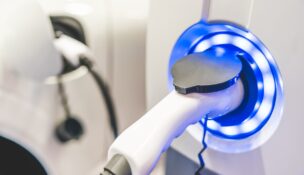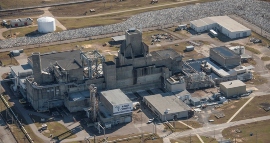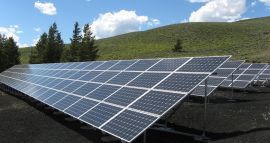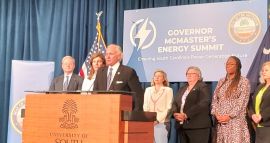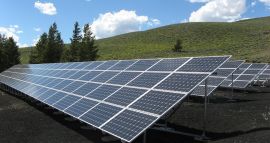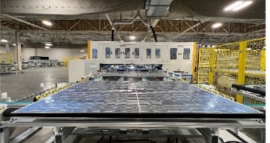Solar heats up in S.C. as business installations surge
Staff //November 30, 2018//
Businesses and residents have collected more than $30 million in incentives from South Carolina’s utilities for launching solar projects since 2014.
That’s when a law went into effect allowing privately owned solar operations to sell electricity back to the state’s power grid. Now, some industry officials, businesses and utilities think it’s time for the state to expand incentives and access to solar power generation.
Act 236 outlined parameters for net metering, a system for collecting solar energy and selling it to electric companies at an agreed-upon rate that is credited against usage.
The net-metering act put limitations on how much can be produced by businesses and consumers — 2% of the state’s average peak generation from five previous years — and how much can be produced by any particular facility, depending on the size.
 Danny Kassis, vice president of customer relations and renewables for S.C. Electric & Gas Co. Inc., said Act 236 was intended to be the first step, not the last shot, for utilities and the state to explore green energy production.
Danny Kassis, vice president of customer relations and renewables for S.C. Electric & Gas Co. Inc., said Act 236 was intended to be the first step, not the last shot, for utilities and the state to explore green energy production.
Kassis said South Carolina was right to be careful in its initial regulation, but solar adoption among residential customers and now businesses has been popular enough that the program could be expanded, so the company supports a review of the law.
“Actually, we really like how the framework of 236 was set up. It created a lot of symmetry,” Kassis said. “A lot of the limitations that were built in, as well as the benefits, were balanced against each other. We think the same framework is right. It is an appropriate time to address a policy change. The state’s ready for version 2.0.”
Commercial solar installations across South Carolina have included major manufacturing plants, software companies and municipal projects. In Columbia, Mr. Suds Car Wash recently installed solar operations for the company’s five area locations. The company said the 315 solar panels will produce between 45% and 100% of each location’s energy consumption.
“Our three largest operating expenses are chemicals, water and electricity,” said Mr. Suds Carwash owner Tom DeKnight in a statement. “With solar, we now have virtually eliminated one of these expenses. That, along with the environmental impact, really made this decision easy.”
Kion North America recently flipped the switch on the largest solar array in Dorchester County. A large part of the forklift manufacturer’s roof on U.S. Highway 78 in Summerville is covered by photovoltaic cells, with wires snaking to collection units that convert the light to electricity and send it to SCE&G’s power grid.
All of the energy Kion North America produces from its rooftop array and a field of solar panels outside the company’s headquarters in Summerville is sold to SCE&G at a fixed rate for 10 years.
“In terms of the total investment, it was certainly less than the 10-year guaranteed rate from SCE&G,” said Daniel Schlegel, vice president of operations for Kion North America Corp. “It’s still a heavy investment in terms of cash capitalized for something like this, but nevertheless the numbers made sense for us.”
The power generation of Kion’s solar array offsets 80% of the company’s electricity costs, Schlegel said. Kion’s solar power array is part of a larger initiative by the company to get energy consumption down to single digits, which included changing all of the facility’s lighting to low-consumption, LED bulbs.
“We looked at all angles: What could we do here locally?” Schlegel said. “One of the elements was our monthly energy consumption, which was obviously quite high in a factory of this size working in two shifts.”
He said that solar was an ideal initiative for Kion as part of its sustainability program because, in the end, the numbers made sense for the business.
“We should have done this earlier,” he said.
Dawn Hipp in the consumer services division of the S.C. Office of Regulatory Staff said data show more residential solar operations have been undertaken in the state than have larger, industrial operations. Some of that is simply because residential solar installations are smaller, cost less and take less time to develop.
“Utility-scale development and installation take a significant amount of time,” Hipp said. “Customer scale refers to residential and nonresidential systems under 1 megawatt installed on a customer’s premise.”
Larger, industrial-sized installations can collect and distribute between 1 megawatt and 10 megawatts.
Every two years, the Office of Regulatory Staff issues a report on net metering in South Carolina that details how incentives are being collected and how costs are being managed for utilities and the state. The first report was issued in July 2017 and showed more than $30 million in incentives have been paid to solar power generators selling back to utility companies.
Jarrett Branham, vice president of operations for Alder Energy Systems, which installed the Mr. Suds solar systems and worked directly with Kion on the company’s solar installation, said Alder has seen an increase in commercial and industrial projects in the past 18 months. Branham thinks this is reflective of where the industry is headed globally.
In addition to installations and consulting in South Carolina, Alder does work in the Northeast and other regions, sometimes performing full installations and sometimes front-end development and engineering work. Alder began 10 years ago as primarily a residential solar business, but that’s changed.
“Right now, we still have our residential arm, and that is about 25% of our business,” Branham said.
He said as more small to midsize businesses consider solar and renewable energy, the No. 1 question concerns initial and ongoing costs, as well as return on investment. He said that every solar project has about a five- to seven-year investment period when a company can expect capital to be tied up; beyond that is when the math begins to make more sense.
“I think the no-brainer question that you get is ‘How will this pay for itself?’ If I’m a business and I’m going to make the investment, I need to understand what’s it going to cost me and what’s the ROI,” Branham said.
Broadly speaking, if a project doesn’t pay for itself in the five- to seven-year range, it’s probably not going to work for a business, Branham said. Variables also determine the viability of the project, he said, including how committed the business wants to be to renewables. He said most businesses look for a balance between green energy and the bottom line.
Schlegel said Kion North America saw the initial 10-year agreement with SCE&G as only the beginning of the company’s solar project, for that reason. Once the contract is up, the system is expected to continue generating electricity for an additional 15 years and can likely be upgraded as technology advances in the renewables sector.
Branham said there’s talk about increasing the solar cap from 2% to 4% at the legislative and regulatory level. He said that when Boeing Co. covered the roof of its final assembly plant in North Charleston with solar panels, it created a buzz in South Carolina about business applications of solar power generation.
Kassis said the state needs a comprehensive energy policy that includes the next step for green power generation. He said the state has done a good job of ensuring that Act 236 was broad enough that the market could determine what would be viable, and solar proved its mettle.
“We’ve gotten there faster than anyone thought they would,” Branham said. “I think everyone has seen that aspect of where we are. Largely, I think that shows the adoption of renewable energy, solar specifically, in this state has been well-received.”
t






